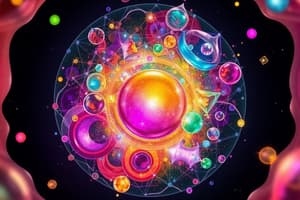Podcast
Questions and Answers
What makes elements considered pure?
What makes elements considered pure?
- They are made up of two or more types of atoms
- They chemically bond with other elements
- They have a set chemical formula
- They are composed only of one type of atom (correct)
Which of the following is an example of a compound?
Which of the following is an example of a compound?
- Gold
- Hydrogen
- Air
- Water (H2O) (correct)
What defines a solution as 'pure'?
What defines a solution as 'pure'?
- It contains multiple solvents
- The solute and solvent do not dissolve
- It is a heterogeneous mixture
- It only consists of one type of molecule (correct)
How many known elements make up everything around us?
How many known elements make up everything around us?
Which of the following is NOT a method for separating mixtures?
Which of the following is NOT a method for separating mixtures?
What is the difference between heterogeneous and homogeneous mixtures?
What is the difference between heterogeneous and homogeneous mixtures?
Why are oranges still considered 'pure' even though they are a mixture?
Why are oranges still considered 'pure' even though they are a mixture?
In which industries is the purity of matter essential?
In which industries is the purity of matter essential?
What defines true purity in matter?
What defines true purity in matter?
How can mixtures be separated?
How can mixtures be separated?
Flashcards are hidden until you start studying
Study Notes
Is Matter Around Us Pure? A Comprehensive Look at Elements, Compounds, Solutions, and Mixtures
As we navigate our everyday lives, we often encounter the concept of "pure" matter. The notion of purity in matter seems simple, but it's a more complex topic than it initially appears. To understand the purity of matter, we must dive deeper into the intricate world of elements, compounds, solutions, and mixtures.
Elements
Elements are the fundamental building blocks of matter. There are 118 known elements, which make up everything around us. Each element shares similar properties due to the atomic structure of its atoms. They are considered pure because, at their most basic level, they are composed only of one type of atom.
Compounds
Compounds are formed when two or more elements chemically bond together. They have a set chemical formula, and their properties are different from the individual elements that make them up. Compounds are also considered pure because they only consist of one type of molecule. Examples include water (H2O), table salt (NaCl), and sugar (C12H22O11).
Solutions
Solutions are homogeneous mixtures that occur when one or more solutes dissolve in a solvent. The solute and solvent are present in varying concentrations, which can be altered by adjusting factors such as temperature, pressure, or concentration. Although solutions are not chemically pure, they can be considered "pure" in terms of their properties. For example, a glass of water dissolving sugar appears and tastes like pure water, even though it technically contains dissolved sugar.
Mixtures
Mixtures are combinations of two or more substances that are not chemically bonded to each other. They can be separated by physical means, such as filtration, evaporation, or sedimentation. Mixtures can be heterogeneous (containing distinguishable parts) or homogeneous (containing substances that are evenly distributed and indistinguishable). Pure matter is not considered in mixtures, as they consist of multiple substances that don't have a specific chemical bond.
Purity in Everyday Life
In everyday life, we often encounter a blend of different materials. For instance:
- An orange is a mixture of water, sugar, and other organic compounds.
- A glass of milk is a mixture of various proteins, fats, lactose, and minerals.
- A rock is a mixture of minerals and other natural materials.
Despite the presence of multiple substances, we still refer to these as "pure" because they are not chemically bonded together.
The Purity of Products
The purity of matter is essential in various industries, such as pharmaceuticals, food, and chemical production. Producers must ensure that their products meet specific purity standards, as impurities can cause adverse side effects or negatively affect the product's quality or performance.
In conclusion, the purity of matter is not a simple concept. It depends on whether the substance is a single element, compound, solution, or mixture. True purity is only found in elements and compounds, while mixtures are not chemically pure. Understanding these distinctions can help us better appreciate the complexity of matter and its importance in our everyday lives.
Studying That Suits You
Use AI to generate personalized quizzes and flashcards to suit your learning preferences.




